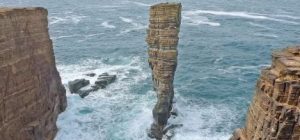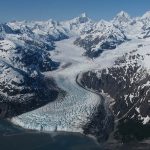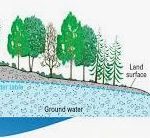Work of Sea
Sea Coast: The land and sea meeting place is called the “coast”. Sea coasts may have many kinds of shapes. The chief types of sea coasts are (i) steep rocky cliffs, (ii) broad low beaches, (iii) small bays alternating with rocky headlands, and (iv) sandy tidal flats.
Shorelines: A “shoreline” is the line along which the water meets the land. Shorelines are classified into three groups: (i) shorelines of emergence, (ii) shorelines of submergence, and (iii) compound shorelines. A shoreline may be uplifted or it may subside to sea level. In some cases uplift and subsidence may operate simultaneously in different parts of the same region.
Shorelines of Emergence: These shorelines are formed when sea coasts are uplifted or the sea level is lowered. The shorelines of emergence are characterised by a relatively straight shoreline, raised beaches, and elevated shore features like sea cliffs, sea caves, etc.
Shorelines of Submergence: These shorelines are formed when either the coastal lands have subsided relative to the sea level or the sea level has risen with respect to the coastal lands. Such shorelines are, generally, very irregular with drowned valleys, deep bays, headlands, and islands. Fiords are formed in glaciated areas.
Compound Shorelines: The shorelines having a complex history of up and down movements relative to sea level, are called compound shorelines.
Erosion by Sea
The forces that shape coasts are (i) erosion caused by sea waves, (ii) transportation & deposition of the rock debris. and (iii) tectonic forces that cause uplift or subsidence of the coastal lands. The major agent of erosion at the shoreline is sea waves. They cause erosion in four ways: (i) hydraulic impact, (ii) abrasion, (iii) attrition, and (iv) chemical action.
- Hydraulic Impact: The impact force of high waves breaking against a rocky cliff during a storm can be very great. This force is enough to dislodge blocks of rocks as well as to enlarge pre-existing fractures.
- Abrasion: The sea waves become more destructive when they pick up rock fragments like pebbles and sand. The waves strike the gravel against the cliff. A great deal of erosion is done in this way.
- Attrition: The pebbles and sand moving to and fro along with the sea waves are further broken down to smaller sizes due to mutual collision.
- Chemical Action of Water: The physical destructiveness of the water is enhanced greatly by the chemical action of seawater. The chemical decay extends and widens the cracks in the rocks and prepares them for disintegration by waves. The chemical action of seawater is particularly seen, where coasts are composed of readily soluble rocks, such as limestones and dolomites.
Shoreline Erosional Features
Shoreline erosion has a deep impact on landforms. Shoreline erosion is a natural process that occurs when the amount of material being transported away from the shoreline is greater than the amount of new material being deposited. It’s often caused by waves and currents, but can also be caused by mass wasting, land subsidence, and extreme weather events. Some prominent features of shoreline erosion are as follows;
- Wave Cut Cliff: The sea waves dash against the rocky shore and cut it actively. Due to continuous erosion at the base of coastal land, a cliff is formed. This cliff is called “Wave Cut Cliff”.
- Wave Cut Bench: The sea waves undercut the cliffs, and produce a notch at the base. This causes the overhanging rocks to fall into the water. In this way, the cliff gradually retreats towards land leaving a submerged rocky platform, which is called a “wave cut bench”.
-

The remnant pillar of a rock is known as Sea Stack. Sea Arch and Sea Stack: Headlands that extend into the sea are vigorously attacked by the waves. The waves erode the rock selectively thereby destroying the softer or more highly fractured rocks at the fastest rate. At first cave-like features are produced at the base of the cliff which are called “sea caves”. When two caves on opposite sides of a headland unite, a gateway-like structure is formed. Such a structure is called a “sea arch”. When the arch falls, a pillar-like structure of rocks is left standing in the sea. Such a remnant pillar of rock is called a “sea stack”.
Transportation by Sea
Most waves approach a shoreline at an angle. Consequently the “uprush” of water from each breaking wave is oblique. However the “back flow” is straight down the slope of the beach. The effect of this pattern in a direction along the shore. This movement is called “beach drift”. This beach drift can transport sand and pebbles hundreds of meters each day.
When a wave strikes a shoreline at an angle, the kinetic energy of the wave is only partly spent in the impact, the remaining energy is used up in forming currents that flow parallel to the shore. These currents are called “longshore currents”. The longshore currents transport sediments along the shore. When the sediment transported by longshore current is added to the quantity moved by beach-drift, the total amount can be very large.
Where the oncoming waves strike at right angles to the shoreline, the undertow currents are formed. The “undertow currents” are returning currents which are formed below the oncoming waves. They transport finer sediment out to the sea.
Deposition by Sea
Where beach drift and longshore currents are active, several depositional features may develop along the shore. The principal depositional features are as follows;
Beach: A beach is the flat mass of sand and gravel that is deposited on sea shores. The sediment of the beach is derived from erosion of adjacent cliffs and from alluvium contributed by rivers.
Wave Built Terrace: Under suitable conditions a part of the sediment is carried beyond the rock bench and is deposited there. In this way a flat platform-like feature is formed, which is called “wave-built terrace”. Towards shore it merges with the beach.
Spits: Where a straight shoreline takes a sharp turn, the longshore currents are not able to flow parallel to it. Such a shore directs the currents into water of increasing depth, where deposition takes places. This results in the formation of a a submerged bar, one end of which is attached to the main land. This bar is called “spit”. The end of the spit becomes often curved landward in response to the wave action. Such a spit is called “hooked spit” or a “hook”.
Sand Bars: Sand bars are the low offshore ridges of sand, which extend parallel to the coast. They commonly enclose a lagoon.
Tombolo: In the lee side of island spits are often formed. If such a ridge connects an island to the main land or joints two islands together, it is called a “tombolo”.
Related posts:
- Work of Sea (Erosion by sea)/ Coastal Erosion
- Erosion carried out by Glaciers (Work of Glaciers)
- Origin and Evolution of the Concept of Cycle of Erosion
- Stages of Valley Development
- What are different types of streams?


Leave a Reply